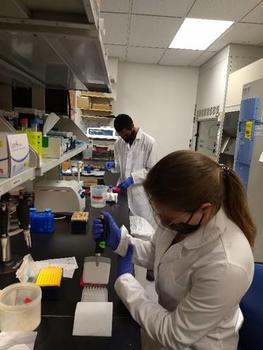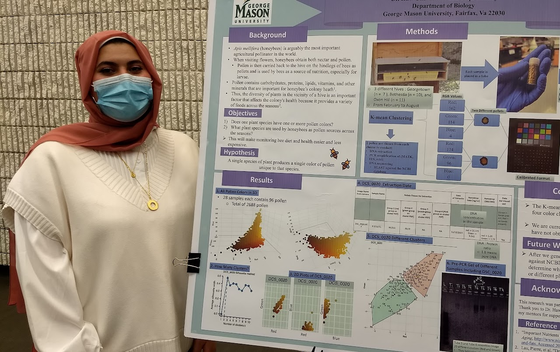Faculty and students at George Mason University are conducting impactful environmental research with the help of the Business for a Better World Center's Honey Bee Initiative.
In collaboration with George Mason University’s Honeybee Initiative and faculty members of the university, Dr. H.C. Lim, an assistant professor at George Mason’s biology department with a background in evolutionary genomics, heads a project that uses DNA sequencing and barcoding to investigate pollen resources of honeybees.
The Honeybee Initiative, a program supported by George Mason University's School of Business and operated by the Business for a Better World Center, is designed to empower communities through sustainable beekeeping and aims to tackle issues including environmental health, economic progress, and food insecurity. As Lim’s research focuses on diversification and speciation of birds as driven by geographic and other factors, this may seem an odd pairing, but students in Lim’s lab work on a variety of research topics, including conservation genetics of captive animals, phylogeography of Southeast Asian mammals, viruses and parasites of bees, snake fungal disease and drivers of avian metapopulation structure.

With funding from Mason’s Institute for a Sustainable Earth and the Office of Student Scholarship, Creativity, and Research (OSCAR), an undergraduate student, Quentin Jamison, was recruited to conduct research under the Undergraduate Research Scholars Program (URSP). While conducting URSP research, he was co-supervised by Dr. Daniel Hanley. Jamison used pollen pellets that were collected by a collaborator, Dr. William Hahn, who affixed pollen traps to artificial bee hives located in various parts of the DMV region.
With these samples collected, Jamison was able to extract DNA using a method called bead milling. After DNA was extracted and purified, he amplified segments of DNA using polymerase chain reactions. These amplified gene segments were then sequenced at Mason’s Microbiome Analysis Center. The resultant sequences were matched against those from a database to identify the plant species that each pollen pellet originated from. The entire process is termed DNA barcoding, and studies such as this are important as it allows researchers to determine the diversity of plants that honeybees use. Since honeybees gather pollen for proteins and lipids, shedding light on their preferred pollen in different localities across the seasons help inform which plant species are needed to properly support a healthy hive. This information will potentially support changes in landscaping that are more diverse and bee-friendly. All of this in turn will hopefully help to increase honeybee populations.

This project was followed by another that aimed to determine if pollen color can be used to predict the actual plant species it came from. While much information can be gained from the pollen itself, identifying its species can be time-consuming and expensive. Often, pollen must be identified through a microscope or using DNA sequencing. A biology department research student, Toqa Elashry, used digital photography and an imaging analysis software to break down the color of each pellet into red, green and blue channel values. Using a statistical approach called k-means clustering, she was able to cluster pollen pellets by color and determine if each color cluster contained pellets that originated from the same plant species. Although Elashry only had one semester to conduct her research, she was able to process and analyze color data of 2600+ pellets.
To date, the findings indicate heavy use of maples during early spring, followed by the use of pears and stone fruits (such as peaches and plums) in the middle of March. During late spring, a larger variety of plants were used, which included honeysuckles, camellias and redbuds. However, plant use patterns varied by sites. Moreover, honeybees in some sites used pollen from fewer plant species probably as a result of the lower plant diversity. The team hopes to gather data across multiple years and from more sites to better characterize spatial and temporal variations. Preliminary findings from the pollen color project determined that color may be an unreliable indicator of plant species. Not only can pollen color of different plant species appear similar, there was also pollen color variation within each plant species, probably due to differences in environmental conditions.
George Mason University’s Business for a Better World Center (B4BW), housed within the School of Business, believes that business can, and should, be a force for good in the world. Guided by the United Nations’ Sustainable development goals, B4BW educates the next generation of business leaders to prepare them to take on the world’s complex challenges; generates knowledge at the intersection of business and sustainability to transform business “as usual”; convenes leaders who have changed their companies and industries for the better so students can apply those lessons to their future careers; effects change by actively engaging in action-oriented partnerships with organizations and communities; and leads an international movement to reshape business education by advancing the ideal of business for a better world. The Honey Bee Initiative, a program designed to empower communities through sustainable beekeeping, is operated by the Business for a Better World Center.
Charish Bishop is a graduate student in the folklore department and graduate research assistant for the Business for a Better World Center.
